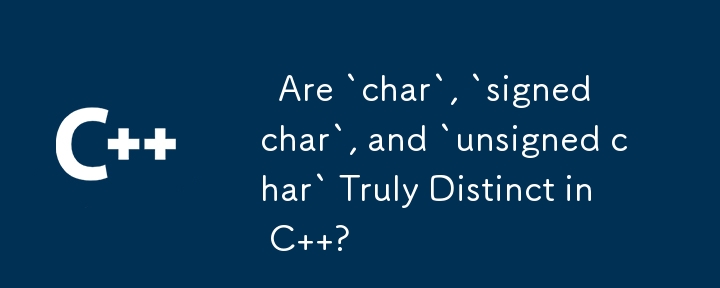C++ 中的「char」、「signed char」和「unsigned char」真的不一樣嗎?
發佈於2024-11-05

C 中的字元類型:不同還是等效?
在 C 中,字元類型 (char) 的行為有時可能與符號和無符號整數,導致混亂。具體來說,以下程式碼演示了這種差異:
#include
typedef signed char int8;
typedef unsigned char uint8;
struct TrueType {};
struct FalseType {};
template
struct isX
{
typedef typename T::ikIsX ikIsX;
};
template struct isX { typedef FalseType ikIsX; };
template struct isX { typedef FalseType ikIsX; };
template struct isX { typedef FalseType ikIsX; };
template bool getIsTrue();
template bool getIsTrue() { return true; }
template bool getIsTrue() { return false; }
int main(int, char **t )
{
cout ::ikIsX >() ::ikIsX >() ::ikIsX >() 此程式碼可以編譯,但對 char 產生的結果與對 int8 和 uint8 產生的結果不同。這是因為 C 將 char、signed char 和 unsigned char 視為三種不同的類型。
相反,int 和 uint32 是等價型別:
template struct isX { typedef FalseType ikIsX; };
template struct isX { typedef FalseType ikIsX; };
這種差異源自於這樣一個事實:char 歷來被用來表示字元和儲存數值。因此,C 透過將普通 char 視為與 int 不同的單獨類型來保持向後相容性。
要確定 char 使用兩種表示法中的哪一種,實現定義的 typedef char_traits::signed 是假如。如果這是 true,則 char 表現為有符號類型;否則,它表現為無符號類型。
最新教學
更多>
-
 如何使用PHP的password_verify函數安全地驗證使用者密碼?使用 PHP 解密加密密碼許多應用程式使用密碼雜湊等加密演算法安全地儲存使用者密碼。然而,在驗證登入嘗試時,將輸入密碼與加密的儲存版本進行比較非常重要。 加密問題password_hash 使用 Bcrypt,一元加密演算法方式雜湊演算法,表示加密的密碼無法逆轉或解密。這是一項安全功能,可確保即使資...程式設計 發佈於2024-11-05
如何使用PHP的password_verify函數安全地驗證使用者密碼?使用 PHP 解密加密密碼許多應用程式使用密碼雜湊等加密演算法安全地儲存使用者密碼。然而,在驗證登入嘗試時,將輸入密碼與加密的儲存版本進行比較非常重要。 加密問題password_hash 使用 Bcrypt,一元加密演算法方式雜湊演算法,表示加密的密碼無法逆轉或解密。這是一項安全功能,可確保即使資...程式設計 發佈於2024-11-05 -
 學習 Vue 部分 建立天氣應用程式深入研究 Vue.js 就像在 DIY 工具包中發現了一個新的最喜歡的工具——直觀、靈活,而且功能強大得驚人。我接觸 Vue 的第一個副業專案是一個天氣應用程序,它教會了我很多關於框架功能以及一般 Web 開發的知識。這是我到目前為止所學到的。 1. Vue 入門:簡單與強大 Vu...程式設計 發佈於2024-11-05
學習 Vue 部分 建立天氣應用程式深入研究 Vue.js 就像在 DIY 工具包中發現了一個新的最喜歡的工具——直觀、靈活,而且功能強大得驚人。我接觸 Vue 的第一個副業專案是一個天氣應用程序,它教會了我很多關於框架功能以及一般 Web 開發的知識。這是我到目前為止所學到的。 1. Vue 入門:簡單與強大 Vu...程式設計 發佈於2024-11-05 -
 Android 應用程式如何連接到 Microsoft SQL Server 2008?將Android 應用程式連接到Microsoft SQL Server 2008Android 應用程式可以無縫連接到中央資料庫伺服器,包括Microsoft SQL Server 2008。這種連接允許開發人員從其行動應用程式存取和管理儲存在遠端伺服器上的資料。 連接方法雖然提供的範例程式碼專注...程式設計 發佈於2024-11-05
Android 應用程式如何連接到 Microsoft SQL Server 2008?將Android 應用程式連接到Microsoft SQL Server 2008Android 應用程式可以無縫連接到中央資料庫伺服器,包括Microsoft SQL Server 2008。這種連接允許開發人員從其行動應用程式存取和管理儲存在遠端伺服器上的資料。 連接方法雖然提供的範例程式碼專注...程式設計 發佈於2024-11-05 -
 以下是一些基於問題的標題選項,重點關注核心問題: * C++ std::可選:為什麼沒有對引用類型進行專門化? (直接、切題) * C++ std::option 中的參考類型C 中的可選:為什麼沒有專門化引用類型? 儘管在像 Boost 這樣的庫中存在對引用類型的專門化,C標準庫的 std::Optional 不提供這樣的功能。這項決定引發了對其理由和潛在替代機制的詢問。 遺漏背後的理由在討論 n3406(可選提案)期間,有人提出了擔憂關於包含可選參考文獻。認識到這些反...程式設計 發佈於2024-11-05
以下是一些基於問題的標題選項,重點關注核心問題: * C++ std::可選:為什麼沒有對引用類型進行專門化? (直接、切題) * C++ std::option 中的參考類型C 中的可選:為什麼沒有專門化引用類型? 儘管在像 Boost 這樣的庫中存在對引用類型的專門化,C標準庫的 std::Optional 不提供這樣的功能。這項決定引發了對其理由和潛在替代機制的詢問。 遺漏背後的理由在討論 n3406(可選提案)期間,有人提出了擔憂關於包含可選參考文獻。認識到這些反...程式設計 發佈於2024-11-05 -
 評估機器學習分類模型大纲 模型评估的目标是什么? 模型评估的目的是什么,有哪些 常见的评估程序? 分类准确率有什么用,它的作用是什么 限制? 混淆矩阵如何描述一个 分类器? 可以从混淆矩阵计算哪些指标? T模型评估的目标是回答问题; 不同型号如何选择? 评估机器学习的过程有助于...程式設計 發佈於2024-11-05
評估機器學習分類模型大纲 模型评估的目标是什么? 模型评估的目的是什么,有哪些 常见的评估程序? 分类准确率有什么用,它的作用是什么 限制? 混淆矩阵如何描述一个 分类器? 可以从混淆矩阵计算哪些指标? T模型评估的目标是回答问题; 不同型号如何选择? 评估机器学习的过程有助于...程式設計 發佈於2024-11-05 -
 如何消除 Eval-Base64_Decode PHP 病毒並保護您的網站?如何像PHP 病毒檔案一樣刪除Eval-Base64_Decode採用eval-base64_decode 技術的病毒,例如您的病毒已經描述過,可能會很麻煩。我們將幫助您了解病毒的性質及其潛在漏洞,並提供有關如何消除病毒的全面指南。 了解病毒此特定病毒以 eval-base64_decode 程式碼...程式設計 發佈於2024-11-05
如何消除 Eval-Base64_Decode PHP 病毒並保護您的網站?如何像PHP 病毒檔案一樣刪除Eval-Base64_Decode採用eval-base64_decode 技術的病毒,例如您的病毒已經描述過,可能會很麻煩。我們將幫助您了解病毒的性質及其潛在漏洞,並提供有關如何消除病毒的全面指南。 了解病毒此特定病毒以 eval-base64_decode 程式碼...程式設計 發佈於2024-11-05 -
 如何在 Serp 中排名 4搜索引擎排名页面 (SERP) 是网站争夺可见性和流量的地方。到 2024 年,在 Google 和其他搜索引擎上的高排名仍然对在线成功至关重要。然而,SEO(搜索引擎优化)多年来已经发生了变化,并将继续发展。如果您想知道如何在 2024 年提高 SERP 排名,这里有一个简单的指南可以帮助您了解最...程式設計 發佈於2024-11-05
如何在 Serp 中排名 4搜索引擎排名页面 (SERP) 是网站争夺可见性和流量的地方。到 2024 年,在 Google 和其他搜索引擎上的高排名仍然对在线成功至关重要。然而,SEO(搜索引擎优化)多年来已经发生了变化,并将继续发展。如果您想知道如何在 2024 年提高 SERP 排名,这里有一个简单的指南可以帮助您了解最...程式設計 發佈於2024-11-05 -
 如何使用多處理在 Python 進程之間共享鎖在Python 中的進程之間共享鎖定當嘗試使用pool.map() 來定位具有多個參數(包括Lock() 物件)的函數時,它是對於解決子進程之間共享鎖的問題至關重要。由於 pickling 限制,傳統的 multiprocessing.Lock() 無法直接傳遞給 Pool 方法。 選項 1:使用 ...程式設計 發佈於2024-11-05
如何使用多處理在 Python 進程之間共享鎖在Python 中的進程之間共享鎖定當嘗試使用pool.map() 來定位具有多個參數(包括Lock() 物件)的函數時,它是對於解決子進程之間共享鎖的問題至關重要。由於 pickling 限制,傳統的 multiprocessing.Lock() 無法直接傳遞給 Pool 方法。 選項 1:使用 ...程式設計 發佈於2024-11-05 -
 Type Script 中 readonly 和 const 的區別這兩個功能的相似之處在於它們都是不可分配的。 能具體解釋一下嗎? 在這篇文章中,我將分享它們之間的差異。 const 防止重新分配給變數。 在這種情況下,hisName 是一個不能重新分配的變數。 const hisName = 'Michael Scofield' hisN...程式設計 發佈於2024-11-05
Type Script 中 readonly 和 const 的區別這兩個功能的相似之處在於它們都是不可分配的。 能具體解釋一下嗎? 在這篇文章中,我將分享它們之間的差異。 const 防止重新分配給變數。 在這種情況下,hisName 是一個不能重新分配的變數。 const hisName = 'Michael Scofield' hisN...程式設計 發佈於2024-11-05 -
 如何使用 Range 函式在 Python 中複製 C/C++ 循環語法?Python 中的 for 迴圈:擴展 C/C 迴圈語法在程式設計中,for 迴圈是迭代序列的基本結構。雖然 C/C 採用特定的循環初始化語法,但 Python 提供了更簡潔的方法。不過,Python 中有一種模仿 C/C 循環風格的方法。 實作循環運算:for (int k = 1; k <...程式設計 發佈於2024-11-05
如何使用 Range 函式在 Python 中複製 C/C++ 循環語法?Python 中的 for 迴圈:擴展 C/C 迴圈語法在程式設計中,for 迴圈是迭代序列的基本結構。雖然 C/C 採用特定的循環初始化語法,但 Python 提供了更簡潔的方法。不過,Python 中有一種模仿 C/C 循環風格的方法。 實作循環運算:for (int k = 1; k <...程式設計 發佈於2024-11-05 -
 TechEazy Consulting 推出全面的 Java、Spring Boot 和 AWS 培訓計畫並提供免費實習機會TechEazy Consulting 很高興地宣布推出我們的綜合培訓計劃,專為希望轉向後端開發使用Java、Spring Boot的初學者、新手和專業人士而設計,以及AWS。 此4個月的帶薪培訓計劃之後是2個月的無薪實習,您可以在實際專案中應用您的新技能—無需任何額外的培訓費用。對於那些希望填補...程式設計 發佈於2024-11-05
TechEazy Consulting 推出全面的 Java、Spring Boot 和 AWS 培訓計畫並提供免費實習機會TechEazy Consulting 很高興地宣布推出我們的綜合培訓計劃,專為希望轉向後端開發使用Java、Spring Boot的初學者、新手和專業人士而設計,以及AWS。 此4個月的帶薪培訓計劃之後是2個月的無薪實習,您可以在實際專案中應用您的新技能—無需任何額外的培訓費用。對於那些希望填補...程式設計 發佈於2024-11-05 -
 Polyfills-填充物還是縫隙? (第 1 部分)幾天前,我們在組織的 Teams 聊天中收到一條優先訊息,內容如下:發現安全漏洞 - 偵測到 Polyfill JavaScript - HIGH。 舉個例子,我在一家大型銀行公司工作,你必須知道,銀行和安全漏洞就像主要的敵人。因此,我們開始深入研究這個問題,並在幾個小時內解決了這個問題,我將在下...程式設計 發佈於2024-11-05
Polyfills-填充物還是縫隙? (第 1 部分)幾天前,我們在組織的 Teams 聊天中收到一條優先訊息,內容如下:發現安全漏洞 - 偵測到 Polyfill JavaScript - HIGH。 舉個例子,我在一家大型銀行公司工作,你必須知道,銀行和安全漏洞就像主要的敵人。因此,我們開始深入研究這個問題,並在幾個小時內解決了這個問題,我將在下...程式設計 發佈於2024-11-05 -
 移位運算子與位元簡寫賦值1。移位運算子 :向右移動。 >>>:無符號右移(零填充)。 2.移位運算子的一般語法 value > num-bits:將值位向右移動,保留符號位。 value >>> num-bits:透過在左側插入零將值位向右移動。 3.左移 每次左移都會導致該值的所有位元向左移動一位。 右側插入0...程式設計 發佈於2024-11-05
移位運算子與位元簡寫賦值1。移位運算子 :向右移動。 >>>:無符號右移(零填充)。 2.移位運算子的一般語法 value > num-bits:將值位向右移動,保留符號位。 value >>> num-bits:透過在左側插入零將值位向右移動。 3.左移 每次左移都會導致該值的所有位元向左移動一位。 右側插入0...程式設計 發佈於2024-11-05 -
 如何使用 VBA 從 Excel 建立與 MySQL 資料庫的連線?VBA如何在Excel中連接到MySQL資料庫? 使用VBA連接到MySQL資料庫嘗試連接使用 VBA 在 Excel 中存取 MySQL 資料庫有時可能具有挑戰性。在您的情況下,您在嘗試建立連線時遇到錯誤。 若要使用 VBA 成功連線至 MySQL 資料庫,請依照下列步驟操作:Sub Connec...程式設計 發佈於2024-11-05
如何使用 VBA 從 Excel 建立與 MySQL 資料庫的連線?VBA如何在Excel中連接到MySQL資料庫? 使用VBA連接到MySQL資料庫嘗試連接使用 VBA 在 Excel 中存取 MySQL 資料庫有時可能具有挑戰性。在您的情況下,您在嘗試建立連線時遇到錯誤。 若要使用 VBA 成功連線至 MySQL 資料庫,請依照下列步驟操作:Sub Connec...程式設計 發佈於2024-11-05
學習中文
- 1 走路用中文怎麼說? 走路中文發音,走路中文學習
- 2 坐飛機用中文怎麼說? 坐飞机中文發音,坐飞机中文學習
- 3 坐火車用中文怎麼說? 坐火车中文發音,坐火车中文學習
- 4 坐車用中文怎麼說? 坐车中文發音,坐车中文學習
- 5 開車用中文怎麼說? 开车中文發音,开车中文學習
- 6 游泳用中文怎麼說? 游泳中文發音,游泳中文學習
- 7 騎自行車用中文怎麼說? 骑自行车中文發音,骑自行车中文學習
- 8 你好用中文怎麼說? 你好中文發音,你好中文學習
- 9 謝謝用中文怎麼說? 谢谢中文發音,谢谢中文學習
- 10 How to say goodbye in Chinese? 再见Chinese pronunciation, 再见Chinese learning

























